We’re already drying up, though much is still green and flowers are still blooming…the long-range forecast is for a “mild drought.” Last summer, in the worst of the drought, we reworked the backyard water feature (which had become overgrown with water irises, among other things.) We started it before we had the 80 acres, designing it for wildlife use from the beginning, with sunny, shady, quiet, and fast-moving sections of varying depths and shapes. In the extreme drought that ended last fall, it was crucial to our wildlife, because neither of the small guzzlers out on the 80 acres was big enough to sustain a good population of amphibians or odonates.
Round Pool, the lowest of the three original pools, was completely cleaned out last summer and replanted lightly with water iris, sedges, etc. around its planting ledge. Water flows in fairly swiftly from the right and out to the left. It had become completely full of water iris, with little room left for frog or toad tadpoles, though dragonfly larvae seemed to do OK there. Now its open surface, though more subject to direct evaporation, offers beautiful reflections and scope for all the water striders to zip around. It’s not very deep.
Between the narrow Rock Pool (the middle of the three) and Round Pool is a narrow channel where water runs over exposed rubber liner–in a sort of groove, but in floods, the extra width of rubber channels rainwater rapidly down–both here and between Round Pool and the Lily Pond, to exit the whole water feature at the low end of the Lily Pond, safely away from the septic system’s pipes. The whole thing forms a sort of aqueduct carrying runoff over that. Natural creeks here tend to alternate wider pools and narrow channels, especially as summer dries up water resource.
In this picture, Round Pool is just being replanted–seen from downstream, the inlet is as the upper center and the outlet stream lower right. The upper stream is not really visible. Another view from last summer shows Rock Pool during maintenance:
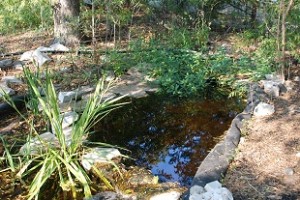 The near end is downstream; upstream, notice the fat black hose coming in from the left–it delivers water to the Upper Pool, mostly concealed plant growth. Upper Pool, lined with smooth small rocks, is a favorite bathing place for small birds.
The near end is downstream; upstream, notice the fat black hose coming in from the left–it delivers water to the Upper Pool, mostly concealed plant growth. Upper Pool, lined with smooth small rocks, is a favorite bathing place for small birds.
This year, the replanted blue water irises in the upper part of the “creek” had recovered from planting shock. Here they are, as seen from the east part of the back yard, growing in a groove just below the little rock dam:
The far end of this planting groove, which is quite shallow, is another place small birds like to drink and bathe. Although I like to watch the birds and other wildlife here, it’s important to give them areas where they feel safe and secluded. And having “hidden” areas is important for satisfying design for humans, too. For instance, when I put my chair just below the little rock dam and look upstream, I get this view:
And when I move down beside Round Pool, I get this:
And by looking directly across Round Pool, I might see one of the last blue iris flowers drooping right down to the water, highlighted by dappled sun:
From another point, more upstream again, I can concentrate on details of the Rock Pool and the cascade down to the planting groove:
The more confident birds (and of course raccoons!) will use the flat rocks that slant very gently into water to drink from, but the drop off at rock’s edge is into moving water, too deep for most birds. Under the overhangs, young frogs hide when spooked.
Downstream, the mass of yellow water iris in Lily Pond conceals the water lilies from view when we’re by the upstream pools…and the upstream pools from view when we’re at the sunny west end with its water lilies:
The Lily Pond’s sides are vertical–there’s a ledge one foot down, two feet wide, all around the 10 x 20 pond, with a central planting space down to almost 4 feet.
What does this beauty have to do with wildlife management? Well…each section, with its different characteristics (velocity, depth, shape of water; shade, sun, etc.) best serves a different type of wildlife. Water depth ranges from almost 4 feet (in the Lily Pond’s lowest section) to an inch (in the shallow are of the upper pools.) Gulf Coast Toads and Plains Leopard Frogs spawn in the Lily Pond; we’ve documented successful reproduction. Several species of Odonates–damselflies, spreadwing damsels, and dragonflies– also reproduce in the water here–some in one pool and some in another. Small snakes (including my favorite Red-lined Ribbon Snake) sometimes live here awhile and others come only to drink. Turtles show up fr0m time to time, though the habitat isn’t large enough for them to stay permanentl. Game-cams have shown raccoons and deer drinking here during the drought; squirrels drink here by day. We’ve photographed many bird species and heard others. (Today, for instance: Painted Bunting, Yellow-billed Cuckoo, Mockingbird, Inca Dove, White-winged Dove, Carolina Wren, Bewick’s Wren, Lesser Goldfinch, House Finch, Blue Jay, all within a couple of hours–and yesterday a Connecticut Warbler on its way north. ) Bees and wasps drink here, as well.
What the birds in the trees overhead drop into the “creek” becomes fertilizer for the plants…and the plants in turn keep the water cleaner. We use collected rainwater to refill the system (there are inevitably leaks, some of them nearly impossible to find, and in summer there’s fierce evaporation), so we don’t have to worry about chemical contamination. We don’t stock fish, because amphibian and odonate reproduction is a high priority. Though many books recommend not putting water features under trees because of the leaves and other debris, in our climate water is normally found in shaded areas…which both lowers the evaporation and gives native wildlife the cover they expect.
In the most recent drought, when the two more distant guzzlers could not keep up with wildlife needs, this larger system (which does require more water) enabled us to serve more wildlife more efficiently.
And every once in awhile (usually in spring, but sometimes in full summer) it provides moments of stunning beauty: last summer’s water lilies
….and this spring’s iris in the water…
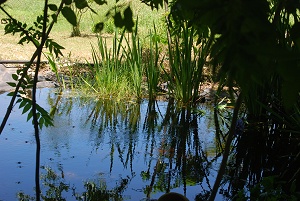
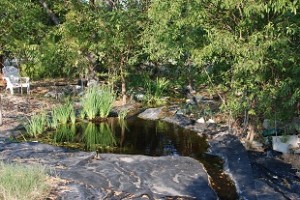
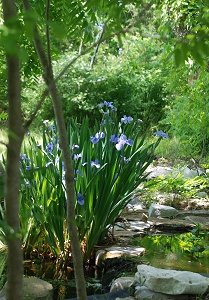
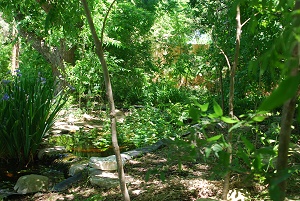
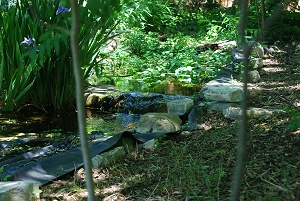
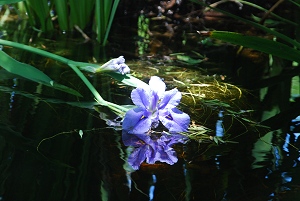
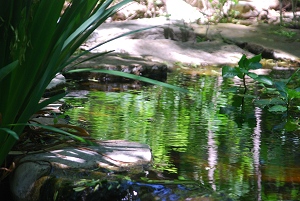
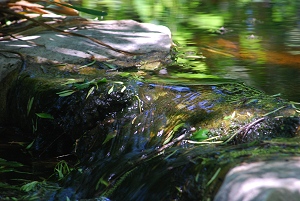
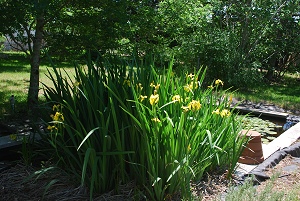
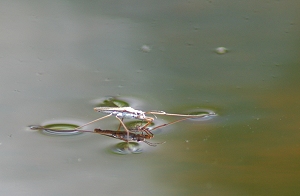
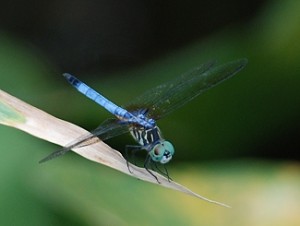
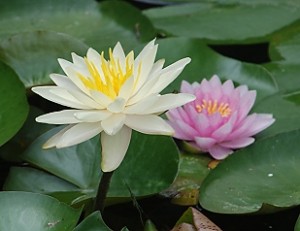
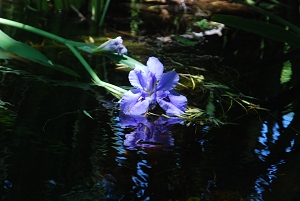
Comment by Melissa Mead — May 3, 2010 @ 5:58 pm
Those are GORGEOUS pictures!
Comment by elizabeth — May 3, 2010 @ 6:09 pm
Thanks! I could not resist that iris just touching the water.
Comment by Delilah — May 6, 2010 @ 3:40 pm
I just looked it up recently — in April a strange bird showed up in our red mulberry tree. A cedar waxwing, about 12 of them. What surprised me was that this (N TX) is winter territory for them.
Delilah
Comment by elizabeth — May 6, 2010 @ 9:57 pm
Delilah: They winter farther south, too, so you may be seeing a flock migrating north from south of you. We had some around until last week; we had them all winter.